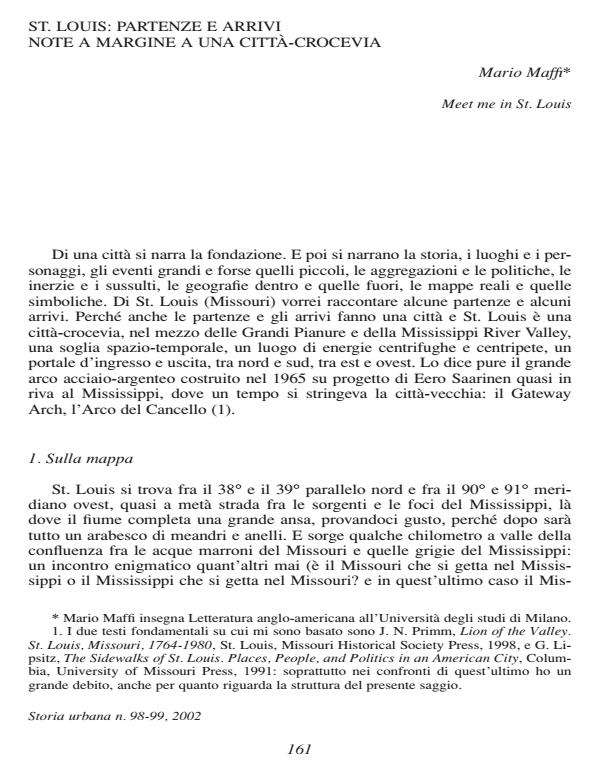St: Louis: partenze e arrivi. Note a margine a una città-crocevia
Titolo Rivista STORIA URBANA
Autori/Curatori Mario Maffi
Anno di pubblicazione 2003 Fascicolo 2002/98-99
Lingua Italiano Numero pagine 22 P. Dimensione file 90 KB
DOI
Il DOI è il codice a barre della proprietà intellettuale: per saperne di più
clicca qui
Qui sotto puoi vedere in anteprima la prima pagina di questo articolo.
Se questo articolo ti interessa, lo puoi acquistare (e scaricare in formato pdf) seguendo le facili indicazioni per acquistare il download credit. Acquista Download Credits per scaricare questo Articolo in formato PDF

FrancoAngeli è membro della Publishers International Linking Association, Inc (PILA)associazione indipendente e non profit per facilitare (attraverso i servizi tecnologici implementati da CrossRef.org) l’accesso degli studiosi ai contenuti digitali nelle pubblicazioni professionali e scientifiche
Following the example of George Lipsitz’s seminal The Sidewalks of St. Louis, the essay draws a series of portraits of those who came to (and left) St. Louis in the span of a century: from the former Native American inhabitants of the area (the Cahokia settlement) to the 1804 explorers Lewis and Clark (the early opening of the West), from the European travellers Francesco Arese and Charles Dickens (who harbored different feelings for what they saw in the Midwest) to the German Socialist Joseph Weydemeyer (a close friend and correspondent of Marx and Engels), from writers Mark Twain and Kate Chopin (so acute in capturing different ages and milieus) to performers Scott Joplin and Josephine Baker (with their great relevance in the field of a mass culture which was starting to cross boundaries both geographical and conceptual), from the millions of visitors of its 1904 World Fair and 1914 Pageant & Masque to modernist poet T.S. Eliot, among the others. In the history of a city whose birth and life stand in the middle of so many things, geographical, social and cultural (a threshold and a hub), the acts of arriving and departing play a central role - one which is further stressed by the highly symbolic contents of such artifacts as the Eads Bridge and the Union Station. The essay thus tries to highlight the often contradictory social and cultural dynamics which led to the formation of the metropolis’s image as a crossroads city, one in which different tensions came (and come) together, giving rise to a complex network of experiences, both private and public.
Mario Maffi, St: Louis: partenze e arrivi. Note a margine a una città-crocevia in "STORIA URBANA " 98-99/2002, pp , DOI: